Quote: “When addiction became profitable, help became optional.”
Chapter 5: Who’s Profiting? The Business Behind the Crisis
Follow the money. It’s always the clearest path to the truth.
The opioid epidemic is not just a medical failure. It is an industry. An empire built on suffering. And while families grieve and communities collapse, there are those who are doing very well.
The Pharmaceutical Engine
At the center of it all is Big Pharma. Purdue Pharma may be the most notorious—its role in aggressively marketing OxyContin with false claims about addiction has been well-documented—but it is not alone. Johnson & Johnson, Endo, Teva, and others all helped saturate the market with high-potency opioids while downplaying the risks.
Billions in revenue. Billions in lawsuits. But few criminal charges. Most fines were written off as the cost of doing business.
Prescribers and the Pain Machine
Many doctors were caught in the machine. Trained to treat pain as a vital sign. Encouraged to prescribe. Rewarded with speaking fees, luxury trips, and bonuses.
Some were well-meaning. Others were pill mills in white coats, writing hundreds of prescriptions a day. Some even sold scripts for cash. In some communities, opioid prescriptions outnumbered residents.
Pharmacies and Distributors
The drugs had to come from somewhere. Distributors like McKesson and Cardinal Health shipped millions of pills to tiny towns without question. Pharmacies filled prescriptions with minimal oversight. Volume meant profit.
When caught, many blamed someone else. “We were just the middlemen.”
Nonprofits and the New Addiction Economy
In recent years, a new player has emerged: the nonprofit industrial complex. Organizations claiming to help the addicted have ballooned in size and funding. With government grants, charitable donations, and foundation money pouring in, some now operate as sprawling empires.
Yet despite the money, the addiction persists. Why? Because success is not measured by recovery. It’s measured by client counts, syringe distribution, shelter occupancy. In some regions, addiction is the only growth industry left.
A Loop with No Exit
The result? A self-sustaining crisis.
Pharma creates dependency. Prescribers deliver the product. Pharmacies dispense it. Addicts cycle through shelters, supervised sites, and detox centers. Nonprofits report service metrics. Governments fund the cycle. Repeat.
And the addict? They remain exactly where the system needs them—dependent.
No Incentive to End the Crisis
Every addict “in treatment” is a line item. Every program funded is a political win. Every overdose reversed is a photo op. But actual recovery? That’s messy, long, and unprofitable.
We must ask: what happens if the crisis ends? What happens to the funding, the salaries, the contracts? What happens to the cities that built entire sectors around managing—not solving—the problem?
Follow the Money, Find the Truth
This isn’t conspiracy. It’s capitalism. And it’s time we stop pretending that compassion and profit can share the same stage without one swallowing the other.
In Chapter 6, we’ll dissect the Four Pillars approach—a model many call the gold standard. But gold can be gilded. And it’s time we scratched the surface.

